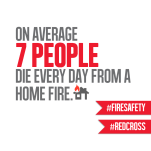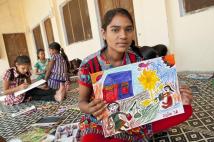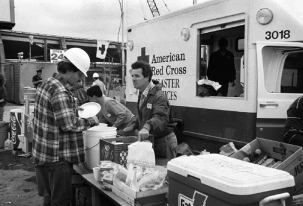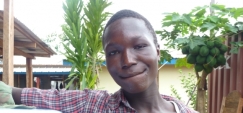This week, the American Red Cross focused mainly on the topic of fires and fire preparedness. They made some especially compelling posts on Facebook and Twitter, such as this one:
“On average 7 people die every day from a home fire. The American Red Cross aims to reduce deaths and injuries caused by home fires with our Home Fires Preparedness Campaign: http://rdcrss.org/1qc6PrR”

This post, text and photo included, appeals to logos by giving a solid statistic. The fact that the statistic mentions “people” as opposed to a less humanistic term adds an emotional component. The red color in the post stands out to the reader and emphasizes the topic of fire. The two hashtags – #firesafety and #redcross- is a nice touch. They contribute to engaging the audience,users of social media, in the conversation and thus promotes the cause even further. This is the overall purpose of the post. The tiny photo of the house on fire adds further appeal to the audience, many of whom are homeowners. Even children would be frightened by the picture. The purpose of spreading awareness and information is achieved through these things.
Doctors Without Borders had a phenomenal week on Facebook, Twitter, and Instagram. They mainly posted about Ebola, Malaria, and maternal mortality in Africa. One of their Facebook posts was especially interesting and appealing to me as a reader, and potential donor:
“We are distributing 50,000 family protection and home disinfection kits in Monrovia to help families protect themselves from #Ebola.
“In order to get the epidemic under control, all infected people must be able to have a bed in a treatment centre, but until the facilities that have been promised materialise, this will be impossible. In the meantime, these kits offer people some protection from an infected family member until they can get the medical care they need in an Ebola centre,” said MSF coordinator Anna Halford.”
http://www.msf.org.uk/article/liberia-massive-distribution-ebola-safety-kits
This post, including a link to an article on their website, tells me that the organization is out there doing significant work. The inclusion of a number like 50,000 adds to the legitimacy and significance of the cause. The inclusion of #Ebola engages the reader in the conversation. The quote from Anna Halford states a specific plan of action that the organization is taking to combat Ebola; this makes the reader feel confident about the actions of the company. In addition, the linked article provides pictures of cheerful African beneficiaries of MSF’s work. They are smiling, cheering, and happy. This appeals to emotion; it shows that the work the organization is doing is positive, impactful, and worthy of further donation. They have established a sense of legitimacy and appealed to ethos.
CARE posted about the International Day Of The Girl and South Sudan. Their posts were aimed at promoting the International Day of the Girl, the philosophies behind it, and raising awareness of the ongoing crisis in South Sudan. One post in particular included thought-provoking rhetoric-
“What would make your world a better place? These girls’ answers will inspire: ”

The rhetorical question inspires the reader and makes you think. The organization then responds with an appeal to pathos with the word “inspire.” This makes me think that the answers to follow are significant and worthy of reading. It makes me want to know more about Day of the Girl. The #DayOfTheGirl hashtag engages social media users in the conversation, and the photo is a nice visual touch. It promotes the cause by adding a face to the picture (literally) and appealing to lovers of art as well.
All three organizations did a great job this week; there is no stand out.









